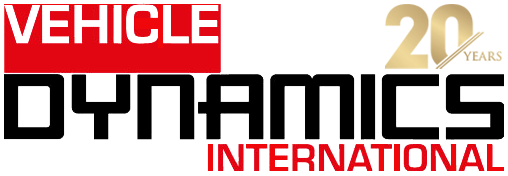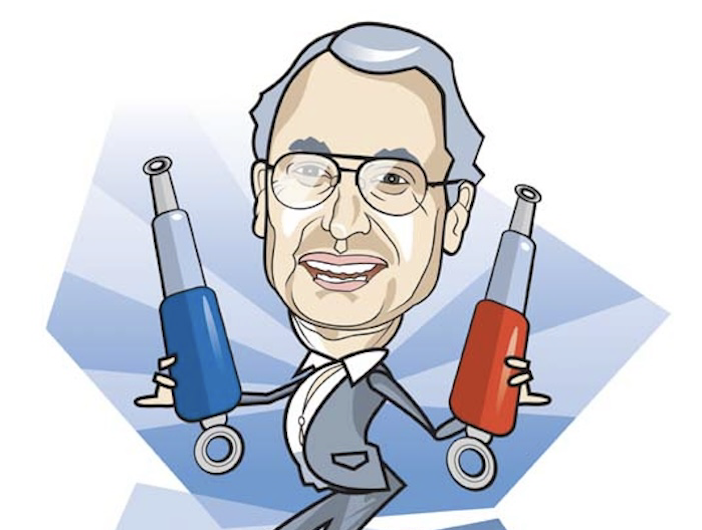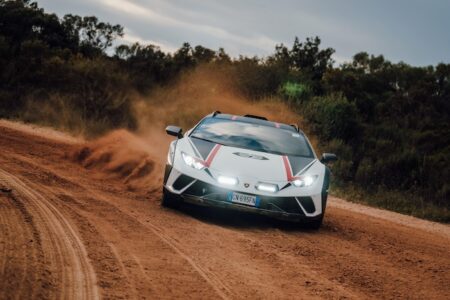From a 2004 issue of Vehicle Dynamics International:
One soon learns that damping affects every aspect of ride comfort, road noise, handling, steering response, and body control. My early experience was with twin-tube dampers. The twin tube has a piston valve and a cylinder end valve. Normally both have bleed (low speed), spring/shim (mid range), and orifice (high speed) control, so with luck you can do almost anything with the compression and rebound force/velocity curves.
Twin-tube struts work well because they can have big-diameter tubes and a large piston rod, and therefore lots of internal flow. But on a typical twin-tube damper the pressure tube is usually quite small in diameter. Problems are often associated with the inherent piston size and a piston rod that is unnecessarily diminutive, which further limits the flow within the valves.
Small passages within the valves mean high local pressures, turbulent flow, potential for local cavitation and associated swish noise, plus lack of fade resistance. Cavitation can also result from a poor balance between the forces attributable to the piston and cylinder end valves dragging air into the hydraulic circuit.
Most of these traits have been lessened with the addition of 3-8bar gas pressure to keep the whole system under pressure and some gas entrained in the oil – à la fizzy drink – but these are still weak points. On the plus side Twin Tubes are very good for their discrete adjustability, and there is nothing like their orifice control capability to deal with big rebound inputs.
In any damper, gas pressure effectively acts constantly on the cross-sectional piston rod area. The 15-25 bar gas pressures used in a monotube would normally cause extremely high piston-=rod extension loads on a strut because of the large rod diameter.
Years ago Bilstein solved this with its simple and very durable ‘upside down’ strut design. A normal piston rod is fixed at the bottom of the strut, and it is the damper body that slides in the strut tube. Still used on competition cars, it was also seen on the 2.8 Capri, but warranty issues due to knocking (the result of the outer tube sticking in the strut casing) killed it. Modern racers solve this issue (very expensively) by making the outer tube run in a strut casing fitted with linear bearings.
In a monotube damper, the air-free oil column is compressed by gas at 15-30 bar behind a floating piston that slides in the casing to accommodate the rod. Monotubes hardly fade or cavitate, but they do get very hot if worked hard. For the same outside diameter, the piston is about 30 per cent larger than the equivalent twin-tube because it runs directly in the outer tube. The piston ports are wide open, so tuning controls are low-speed bleed and deflecting shims only.
More recently, systems have been introduced whereby the bleeds can be somewhat independently tuned, but once the shim stack opens, the damping forces tend to be a straight line with velocity. Apart from constant extension loads in the 230-300N range, which preloads the top mount, I have found the biggest problem with monotubes is the lack of discrete adjustability and high-speed orifice control.
Once the damping has been rough cut with any damper, you absolutely cannot look to the damper test machine for the answers. A tuning exercise could have at least 30 damper settings within a 5 per cent force/velocity characteristic of each other, each one achieved with different components. Those who work with dampers have to be hardy souls. As Job One approaches and you are still on the same 35th front damper setting, you see the disbelief in management’s eyes.
For me, the questions are always the same. Why, for the same forces, are thick shims good for handling but poor for rolling comfort, while thin shims are better for comfort and worse for shake? Why, for the same forces, is rolling comfort so dramatically affected by the thickness of the shims employed?
Why does the thickness of a bleed shim of equivalent by-pass area affect rolling comfort so much? All this with force/velocity curves that can be laid over one another. Changes in twin-tube orifice size normally have a measurable effect on forces above 0.5m/sec, so why do orifice area changes affect ride comfort when the damper is moving much more slowly than that? Answers on a postcard please!
Me, I like Twin Tubes, but monotubes are more likely to behave in production as they did when management signed them off. But they almost always cost more…





